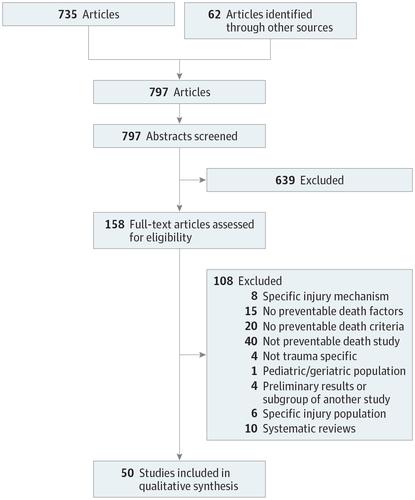JAMA Surgery ( IF 16.9 ) Pub Date : 2018-04-01 , DOI: 10.1001/jamasurg.2017.6105 Jud C. Janak 1 , Jonathan A. Sosnov 2 , Joan M. Bares 3 , Zsolt T. Stockinger 1 , Harold R. Montgomery 1 , Russ S. Kotwal 1 , Frank K. Butler 1 , Stacy A. Shackelford 1 , Jennifer M. Gurney 1 , Mary Ann Spott 1 , Louis N. Finelli 4 , Edward L. Mazuchowski 4 , David J. Smith 5

|
Importance Military and civilian trauma experts initiated a collaborative effort to develop an integrated learning trauma system to reduce preventable morbidity and mortality. Because the Department of Defense does not currently have recommended guidelines and standard operating procedures to perform military preventable death reviews in a consistent manner, these performance improvement processes must be developed.
Objectives To compare military and civilian preventable death determination methods to understand the existing best practices for evaluating preventable death.
Evidence Review This systematic review followed the PRISMA reporting guidelines. English-language articles were searched from inception to February 15, 2017, using the following databases: MEDLINE (Ovid), Evidence-Based Medicine Reviews (Ovid), PubMed, CINAHL, and Google Scholar. Articles were initially screened for eligibility and excluded based on predetermined criteria. Articles reviewing only prehospital deaths, only inhospital deaths, or both were eligible for inclusion. Information on study characteristics was independently abstracted by 2 investigators. Reported are methodological factors affecting the reliability of preventable death studies and the preventable death rate, defined as the number of potentially preventable deaths divided by the total number of deaths within a specific patient population.
Findings Fifty studies (8 military and 42 civilian) met the inclusion criteria. In total, 1598 of 6500 military deaths reviewed and 3346 of 19 108 civilian deaths reviewed were classified as potentially preventable. Among military studies, the preventable death rate ranged from 3.1% to 51.4%. Among civilian studies, the preventable death rate ranged from 2.5% to 85.3%. The high level of methodological heterogeneity regarding factors, such as preventable death definitions, review process, and determination criteria, hinders a meaningful quantitative comparison of preventable death rates.
Conclusions and Relevance The reliability of military and civilian preventable death studies is hindered by inconsistent definitions, incompatible criteria, and the overall heterogeneity in study methods. The complexity, inconsistency, and unpredictability of combat require unique considerations to perform a methodologically sound combat-related preventable death review. As the Department of Defense begins the process of developing recommended guidelines and standard operating procedures for performing military preventable death reviews, consideration must be given to the factors known to increase the risk of bias and poor reliability.
中文翻译:

军事和平民确定潜在可预防死亡方法的比较-系统评价
重要性 军事和民用创伤专家发起了一项合作努力,以开发一个综合的学习创伤系统,以减少可预防的发病率和死亡率。由于国防部目前尚无建议的指南和标准操作程序来以一致的方式执行军事上可预防的死亡审查,因此必须制定这些性能改进流程。
目的 比较军事和民用可预防死亡的确定方法,以了解评估可预防死亡的现有最佳实践。
证据审查 这项系统的审查遵循了PRISMA报告指南。从开始到2017年2月15日,使用以下数据库搜索英语文章:MEDLINE(Ovid),循证医学评论(Ovid),PubMed,CINAHL和Google Scholar。最初对文章进行资格筛选,并根据预定标准将其排除在外。仅审查院前死亡,仅院内死亡或两者兼有的文章均符合纳入条件。研究特征的信息由2位研究者独立提取。报告了影响可预防死亡研究的可靠性和可预防死亡率的方法学因素,可预防死亡率定义为潜在可预防死亡人数除以特定患者群体中的死亡总数。
结果 五十项研究(8项军事和42项民用)符合纳入标准。总共审查了6500例军事死亡中的1598例,审查了19 108例平民死亡中的3346例为可预防的类别。在军事研究中,可预防的死亡率为3.1%至51.4%。在民用研究中,可预防的死亡率为2.5%至85.3%。关于因素的高度方法异质性,例如可预防的死亡定义,审查过程和确定标准,阻碍了可预防死亡率的有意义的定量比较。
结论和相关性 定义不一致,标准不兼容以及研究方法总体异质性阻碍了军事和民用可预防死亡研究的可靠性。战斗的复杂性,矛盾性和不可预测性需要独特的考虑因素,才能进行在方法论上与战斗有关的可预防的死亡评估。随着国防部开始制定建议的指导方针和标准操作程序以进行军事可预防的死亡审查的过程,必须考虑已知的因素,这些因素会增加产生偏见和可靠性差的风险。


























 京公网安备 11010802027423号
京公网安备 11010802027423号